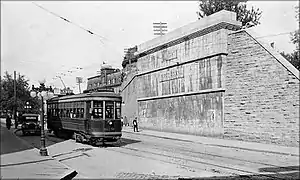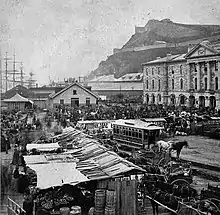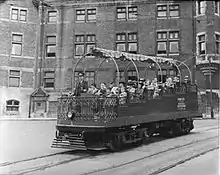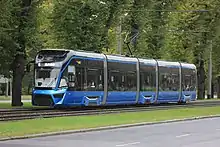Quebec City Tramway
The Quebec City Tramway is a proposed light rail system; a former streetcar system existed between 1897 and 1948.
 Streetcar on St. John Street circa 1930 | |||
| Overview | |||
|---|---|---|---|
| Native name | Tramway de Québec | ||
| Locale | Quebec City, Canada | ||
| Transit type | Light rail/tram | ||
| Number of lines | 1 | ||
| Number of stations | 39 | ||
| Operation | |||
| Began operation | 2026 (estimated) | ||
| Operator(s) | Réseau de transport de la Capitale | ||
| Technical | |||
| System length | 23 km (14 mi) | ||
| |||
First tramway (1865 to 1948)
Horsecars

In fall 1863, a group of local businessmen and public figures from Quebec City presented a petition at the Parliament of the Province of Canada for the incorporation of a streetcar company. Among them were Pierre Garneau and John Lemesurier, future mayors of Quebec City, entrepreneurs Guillaume-Eugène Chinic and Cérice Têtu and many others. The group was incorporated under the name Quebec Street Railway Company.[1] (QSRC) on October 15, 1863. It obtained the right to build a system for the city five neighbourhoods. Nevertheless, it was mainly the commercial and port sector of the Lower Town that interested the company. First, they established a horse-drawn omnibus between Champlain Market and St. Ours Street barrier. Wooden rails were embedded in the roadway in this corridor to create the first horsecar line. The service started on August 18, 1865. The arrival of streetcars disrupted centuries-old practices: a ticket cost 5 cents while a horse-drawn carriage varied between 25 and 50 cents. Coach drivers denounced unfair competition and some vehicles were vandalized, rails removed and drivers brutalized. Also, the city and the company were sometimes inconsistent, regarding for instance who was responsible for road maintenance. Moreover, for financial reasons, the company refused to expand its network to the Upper Town, which would also have benefited from public transport. In 1874, the QSRC proceeded to an extension toward Saint-Sauveur, which was not part of the city at the time, to build its depot and avoid paying taxes to the municipality.
Streecars appeared in the Upper Town from 1878 onwards with the creation of a second company, the St. John Street Railway Company Ltd. It built a line linking the Château Frontenac to De Salaberry Avenue through St. John Street. Stables were situated at the intersection with Philippe-Dorval Street.
Electrification and networking

The desire to create a real electrified city system was felt throughout 1890s, especially with the arrival of the electric streetcars in Montreal in 1892. The Quebec, Montmorency and Charlevoix Railway Company and its president, businessman and engineer Horace Jansen Beemer, got an exclusive franchise from the Quebec City Council to this end. They created the Quebec District Railway Company, a subsidiary responsible for managing the city streetcar system. This branch purchased two existing tram companies. Major works were needed: the Montmorency Electric Power Company had to modernize its facilities to provide the new energy demand from the electric network, a metal structure was essential for tram traffic between the Upper and Lower town with a very smooth slope, St. Jean's Gate was demolished to improve traffic flow with Old Quebec, etc. In the summer of 1897, the four lines of this united and electrified public transport system were opened. Côte Dinan trestle, connecting St. Paul Street to the Hôtel-Dieu de Québec, received its first trams in December. From then on, trams would be pulled by horses only when they broke down.
| Line | Route | Opening |
|---|---|---|
| The "red diamond line" served the Lower Town. It linked Champlain Market to Saint-Sauveur (Aqueduc Street) | July 19, 1897 | |
| The "Maltese Cross line" served the Upper Town. It linked the Château Frontenac to Mapple Street through St. John Street and the Grande Allée | August 25, 1897 — September 16, 1897 | |
| The "white circle on green square line" connected the lower and the upper town through Côte d'Abraham. It linked the Château Frontenac to Victoria Park | August 1897 | |
| The "white circle line" connected the lower and the upper town through Côte Dinan trestle. It linked the Château Frontenac to Champlain Market | December 29, 1897 |
New streetcars built in New York could accommodate 25 to 27 passengers up to 50 people and are equipped with heaters. This new public transport participated in the rapid expansion of the city toward Ville-Montcalm, which was growing in population and confirming its residential character.
Expansion, apogee and decline

In 1899, railway and power companies merged to form the powerful Quebec Railway Light & Power Company, a trust in the power and transport sectors for the whole Quebec City area. This company, later known under the name Quebec Power, would run the tramway until its closure in 1948.
In 1910, the network was expanded to Sillery and in 1912, to Beauport. The tramway was at its peak and covered almost the entire city. In 1932, the network stretched from Sillery to Montmorency. At the time, 11 lines in total were in service.
| # | Line | Terminus | ||
|---|---|---|---|---|
| 1 | Saint-Sauveur | Champlain Market | Saint-Malo Industrial Park | |
| 2 | Saint-Vallier | Carré Parent | Saint-Charles Cemetery | |
| 3 | Limoilou | Château Frontenac | Externat Saint-Jean-Eudes | |
| 4 | Exposition | Montcalm Market | Exhibition Park | |
| 5 | Charlesbourg | 1st Ave / Lilas Street | 3th ave / 10th Street | |
| 6 | St. John Street | Mapple Street | City Hall of Quebec City | |
| 7 | Grande Allée | Mapple Street | Château Frontenac | |
| 8 | Saint-Sacrement | Champlain Market | École de Chimie et des Mines | |
| 9 | Sillery | Mapple Street | Maguire Avenue | |
| - | Québec - Montmorency | C.P.Ry Station | Clermont | |
| 11 | Kent House | Crown Street | Kent House | |
From 1937 onwards, buses' popularity was increasing and caused the disappearance of the trams. On May 26, 1948, the last line serving Saint-Sauveur was permanently closed.
 Streetcars at Place D'Youville in 1938.
Streetcars at Place D'Youville in 1938. Streetcars at Place D'Youville in 1944.
Streetcars at Place D'Youville in 1944. Rails, Grande Allée, 1945.
Rails, Grande Allée, 1945. Tram 901 in 1947.
Tram 901 in 1947.
Proposal
History
- 2000: The Ministère des Transports du Québec gives the RTC the mandate to carry out an opportunity and feasibility study for the insertion of a tramway along the Metrobus routes.
- 2003: The study recommends the construction of a tramway network in the city.
- 2005: The City adds the tramway to its 2005-2025 Master Development Plan.
- 2010: The City committee for sustainable transport submit a report. It recommends to build a tramway line before 2030.
- 2015: Second feasibility study. The City chooses bus rapid transit instead of tramway.[3]
- 2017: Six weeks after municipal elections, the reelected mayor (Régis Labeaume) goes back to a tramway concept.
2003: First attempt
In 2003, the Réseau de transport de la Capitale publishes an opportunity and feasibility study on a light rail system following a government request in 2000. The study shows that a tramway system could be positive for the city. The initially presented project proposes to insert the tram along the existing 800 and 801 Metrobus axes. Those routes pass through high-population-density sectors. With a length of 21.5 km, the infrastructures would take four years to build. The service frequency would be 5 to 10 minutes.
2010: Project presented by the City Committee for sustainable transport

On June 10, 2010, the City Committee for sustainable transport recommended to build two tramway lines for $1.5 billion. The first line would be 22.3 km long. Starting on the Saint Lawrence south shore, trams would cross the Quebec Bridge, then run along Laurier Boulevard, going through the Laval University campus, down Côte Nérée-Tremblay, along Charest Boulevard to the Quebec Courthouse. From there, they would go north, taking Capucins Boulevard and Chemin de la Canardière to finally end in the future D'Estimauville Ecodistrict. The second line would separate from the first line in Saint-Roch neighbourhood to service Quebec Parliament Hill with a final stop near the Grand Théâtre de Québec. That line, 6.6 km long, would link the Grand Théâtre to Charlesbourg. It would pass through Pointe-aux-Lièvres, ExpoCité to Galeries Charlesbourg. A possible extension would be in the Upper town in the direction of Sainte-Foy.
This project was finally abandoned in 2015 in favour of bus rapid transit (SRB). The bus project was in turn cancelled in April 2017 following the withdrawal of the Lévis municipal authorities.
2018: Structure-enhancing public transit network

In December 2017, a few weeks after the November municipal elections, reelected Mayor Régis Labeaume said his election promise for a new transport system would after all take the form of a light rail system. The current political context enables a great investment from provincial and federal governments in public transit, unlike the 2010 project.
In March 2018, the City, along with the Government of Quebec, announced the construction of a 23 km-long tramway line for $3 billion.[4] The line will link Charlesbourg to Cap-Rouge, passing through Quebec Parliament Hill. There will be a 3.5 km tunnel in this part. The service frequency will be 3 to 5 minutes in peak periods, 10 to 15 minutes during the day and weekend. Passenger capacity will be 260 per tram. The Quebec City tramway should be in service in 2026.[5]
2020: Reassessment of tramway project
In November 2020, Quebec's environmental review board, BAPE, has turned down Quebec City's $3.3-billion tramway project proposal. In the report, BAPE stated that planners should have also considered a subway or light rail system, rather than a tramway. The BAPE also states that the existing tramway proposal doesn't do enough to serve the city's suburbs, which are rapidly growing. Furthermore, BAPE questioned whether a tramway system could cope with the city's winter weather, or how it would be integrated into the landscape.[6] Quebec's Transport Minister, François Bonnardel, announced that the government was withdrawing the support for Quebec City's proposed tramway network, which he said won't go ahead unless it is reconfigured to better serve the suburbs.[7]
References
- "Transit History of Quebec, Quebec". home.cc.umanitoba.ca. Retrieved 2019-06-07.
- Pharand, Jacques (1998). Les tramways de Québec. Beauport: Publications MNH. p. 190. ISBN 978-2-921912-33-4.
- ICI.Radio-Canada.ca, Zone Société-. "Le service d'autobus rapide plutôt qu'un tramway, à moyen terme". Radio-Canada.ca (in French). Retrieved 2019-06-07.
- Page, Julia (March 16, 2018). "Quebec City unveils plans for $3-billion tramway network, wants feds and province to pay". CBC/Radio-Canada. Retrieved 2019-06-07.
- March 16, Presse Canadienne Updated; 2018 (2018-03-16). "Mayor, premier unveil plans for $3-billion tramway for Quebec City | Montreal Gazette". Retrieved 2019-06-07.CS1 maint: numeric names: authors list (link)
- Van Dyk, Spencer (November 9, 2020). "Province's environmental review board rejects Quebec City's proposed tramway". Canadian Broadcasting Corporation. CBC News. Retrieved 28 December 2020.
- "Province won't fund Quebec City's $3.3B tramway unless changes are made". Canadian Broadcasting Corporation. CBC News. November 10, 2020. Retrieved 28 December 2020.
External links
- Official Website (in French)
